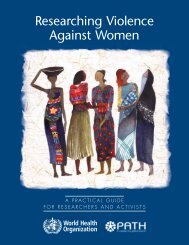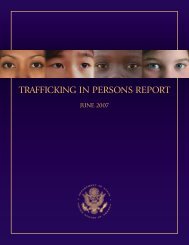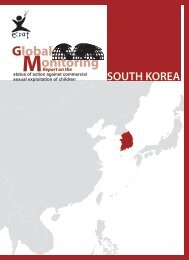Download PDF - Violence Against Children - East Asia and the ...
Download PDF - Violence Against Children - East Asia and the ...
Download PDF - Violence Against Children - East Asia and the ...
Create successful ePaper yourself
Turn your PDF publications into a flip-book with our unique Google optimized e-Paper software.
ecommendations<br />
National <strong>and</strong> international level<br />
responses<br />
Few of <strong>the</strong> above recommendations can<br />
succeed without support from critical<br />
national <strong>and</strong> international actors.<br />
NGOs such as World Vision can view as part<br />
of <strong>the</strong>ir role <strong>the</strong> extension of <strong>the</strong> practical role<br />
of governance in key areas of protection,<br />
prevention <strong>and</strong> development. However, it<br />
must be kept in mind that states bear primary<br />
responsibility to protect children; private<br />
sector <strong>and</strong> civil society activity should not be<br />
seen as supplanting <strong>the</strong> role of states.<br />
At <strong>the</strong> same time, national governments<br />
that are willing to promote child protection<br />
must also be able to count on <strong>the</strong> support of<br />
international actors. International institutions<br />
seeking to direct economic policy, promote<br />
good governance or improve <strong>the</strong> rule of law<br />
in countries should ensure that children<br />
benefit from <strong>the</strong>se measures.<br />
The following recommendations are<br />
addressed not only to national governments<br />
but to donors, policy makers <strong>and</strong> o<strong>the</strong>r<br />
international actors:<br />
• Ensure <strong>the</strong> CRC is incorporated into staff<br />
training <strong>and</strong> general programs. Be willing to<br />
consider creative approaches that may<br />
contribute to promoting child protection.<br />
• Review existing processes <strong>and</strong> policies that<br />
may be restricting <strong>the</strong> capacity of people<br />
<strong>and</strong> institutions for change.<br />
• Support improvement in national government<br />
policy by allocating resources to enable its<br />
implementation <strong>and</strong> honour its intention. For<br />
example, provide adequate resources to<br />
streng<strong>the</strong>n <strong>the</strong> mechanisms of protection for<br />
children through increased law enforcement<br />
or awareness-raising in schools.<br />
• Invest in research, strategic collaboration<br />
<strong>and</strong> advocacy, which may be most effective<br />
in <strong>the</strong> long term in reducing risks to children,<br />
<strong>and</strong> has <strong>the</strong> added value of promoting civil<br />
society <strong>and</strong> responsive government.<br />
Collaboration also helps to avoid duplication.<br />
• Invest in underst<strong>and</strong>ing <strong>and</strong> planning for<br />
emerging issues. Given <strong>the</strong> increasing<br />
urbanisation in <strong>Asia</strong>, for example, greater<br />
attention is warranted to research <strong>and</strong><br />
respond to emerging child protection issues<br />
of urban poor communities. 8<br />
• Ensure that overseas development assistance<br />
(ODA) provides adequate resources to<br />
specifically assist children at risk, through<br />
policies <strong>and</strong> targeted programmes.<br />
8<br />
Social Protection Strategy, <strong>Asia</strong>n Development Bank, 2001<br />
89

















